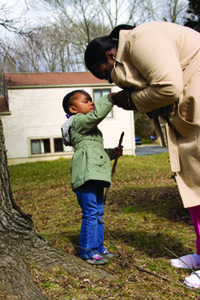It is well known that where people live can have a big impact on their life. For children, that can affect not only their health, safety, and development, but also their future.
The Section 8 Housing Choice Voucher Program has long enjoyed broad bipartisan support because its design appeared to expand families’ ability to choose where to live. Yet mounting evidence indicates that this core feature of the program is more potential than real.
Families with vouchers live in only slightly less poor neighborhoods than similar tenants without housing assistance, although neighborhood outcomes are somewhat better for black voucher households and significantly better than for the public housing and project-based Section 8 programs.
The performance of voucher recipients’ neighborhood schools is particularly alarming. A recent analysis shows that a smaller share of voucher households with children live near schools ranked in the top 50 percent than poor households generally; black voucher households with children live near schools that are only marginally less poor and better performing than other poor black households, and Hispanic voucher households live near schools that have slightly lower proficiency scores on standardized tests than other poor Hispanic households with children.
The stress children experience from growing up poor, particularly in neighborhoods of concentrated poverty, can be toxic to their health, education, and long-term economic well-being. Yet, vouchers can provide families with access to better opportunities.
Using a voucher to move out of an extreme-poverty neighborhood literally saves children’s lives by sharply reducing deaths from disease or accidents among girls. And where housing policies have allowed low-income children to attend high-performing, economically integrated schools over the long term, the students scored significantly higher on math and reading tests than comparable children who attended higher-poverty schools.
That’s why it is critical to better equip those helping Housing Choice Voucher families with the tools they need to help these families move to more opportunity-rich neighborhoods.
A new toolkit, “Expanding Choice: Practical Strategies for Building a Successful Housing Mobility Program,” published by the Poverty & Race Research Action Council and the Urban Institute, provides a step-by-step outline and extensive resources for public housing agencies, state and local governments, and non-profits interested in helping Housing Choice Voucher families move to and stay in higher-opportunity neighborhoods. (I contributed a few sections to the toolkit.)
The guide shows how to:
• Set goals in light of local markets and priorities;
• Identify opportunity-rich neighborhoods;
• Reach out to landlords effectively;
• Recruit and assist target families;
• Use existing discretion under HUD policies — or
get waivers of HUD rules — to expand families’
search time, set adequate subsidy levels, and
provide security deposits; and
• Fund a local or regional program.
While the new toolkit demonstrates how local agencies can help families use their housing vouchers to move to neighborhoods with greater opportunities, more steps are needed to enable the voucher program to achieve its full potential. HUD could make it easier for agencies and families to succeed, and to encourage agencies to adopt policies to achieve better results, by modifying some of its current policies. As the evidence shows, making these changes a priority can make a significant difference in the lives of children receiving housing vouchers not only today, but for a lifetime.
(Photo: Kaswana Cook and her daughter Patience relocated through Baltimore’s Housing Mobility Program. © Anastasia Tantaros.)





Comments